The LTS Hub
This hub explores Long-term Low GHG Emissions Development Strategies (LTSs) under the Paris Agreement of 2015 to inform policymakers, researchers and other stakeholders interested in developing, supporting or assessing LTSs.
This hub is informed by two recent publications (co-)published by NewClimate Institute:

The LTS Hub presents recently published work by NewClimate Institute on the development of LTSs under the Paris Agreement. The seven content tabs below contribute to answer the following guiding questions when developing an LTS in 2020 or thereafter:
- What can an LTS and LTS development process look like? → Refer to content sections 1 and 2
- How to consider country-specific circumstances and available domestic resources when developing an LTS? → Refer to sections 3 , 4 and 5
- What can be learned from LTSs already submitted to the UNFCCC? → Refer to section 6
More information on the following inputs available in Chapter 3 (Development of LTSs) of the ‘NDC Update Report 2019 – Long-term, society-wide visions for immediate action’.
The Paris Agreement calls for “long-term low greenhouse gas emission development strategies” (LTSs) but gives little guidance beyond that. Few of these LTSs have been developed so far, and there seems to be a lack of common understanding of what the scope and format of an LTS should be.
We propose that LTS encompass eight key elements relating to both the content, and the process of developing an LTS. The eight elements are identified and discussed based on the following literature: CAN Europe (2018), Cox (2019), Ecologic Institute (2017), Levin et al. (2018), Waisman et al. (2019), Williams and Waisman (2017), the World Bank and Ecofys (2019) and WRI (2019) (see Tab 7).
- LTSs are about the process and not the document. The LTS submission itself can be a concise, strategic document well aligned with other processes and strategies to avoid duplication. The process of developing an LTS, however, should build on robust analysis and extensive public and private stakeholder engagement.
- LTSs should include pathways for GHG emission until 2050 and beyond. Ideally this should include national pathways that are in line with the long-term temperature goal of the Paris Agreement. Including quantified pathways provides a clear indication of where each sector is heading and allows stakeholders to develop a common vision. The inclusion of Paris compatible pathways is an important element needed to trigger the radical rethink that is required across the economy. In Chapter 4, we propose an approach to align LTSs with the temperature goal of the Paris Agreement.
- LTSs should encompass all sectors of the economy, ideally also providing sectoral pathways and including international aviation and shipping. Sector pathways are interdependent: reducing emissions more (or less) in one sector will require a smaller (or larger) effort from others, and some sectors are coupled in their decarbonisation efforts. Ultimately all sectors must go to zero in the second half of this century.
- LTSs should be considered as an ongoing visioning exercise which needs to align with policy and implementation planning at the sectoral level. Foresight into the future remains imperfect and only implementation will tell which strategies will be successful or not. Technology breakthroughs and other economic and social developments require an ongoing process to ensure that the latest knowledge is always accounted for. In line with the Global Stocktake for the NDCs, LTSs should include a process to revise and update “the vision”, along the lines of a ratcheting-up mechanism.
- LTSs require extensive coordination efforts (i.e. inter-ministerial) and participatory processes including the private sector and civil society. The magnitude of the challenge demands a comprehensive approach that involves all of society. Implementation will need to be coordinated and delivered by line ministries, which in turn requires alignment across responsible entities.
- Beyond providing a long-term perspective, LTSs should reflect on immediate next steps in the short term and strategic enablers to decarbonise the economy. Without defining concrete actions (for example in the form of sectoral commitments) LTSs run the risk of becoming yet another visioning exercise that is not mainstreamed into policy and implementation planning.
- LTSs should clarify how much financing and other support is required (if applicable) in addition to the required contribution of national resources. The Paris Agreement foresees that all countries pursue an ambitious low-emissions development path. However, given differences in country circumstances, equity considerations set out in the UNFCCC principle of “common but differentiated responsibilities” need to be observed. This means that countries with higher capacities and historical responsibility need to support those with less means to achieve accelerated decarbonisation. At the same time, all countries need to redirect their fiscal revenues and spending towards low emissions development.
- LTSs need to consider and be developed in line with the 2030 Sustainable Development Goals as well as with other national long-term objectives, policies and measures. Whilst emphasis should be put on long-term decarbonisation pathways, these need to reflect adaptation challenges and ensure development objectives can be met and potential trade-offs be minimised or managed accordingly.
More information on the following inputs is available in Chapter 2 (LTS development under country-specific circumstances) of the guide on ‘Making long-term low GHG emissions development strategies (LTSs) a reality – A guide to policy makers on how to develop an LTS for submission in 2020 and future revision cycles developed’ and in Chapter 4 (Alignment of LTSs in the context of the Paris Agreement) of the ‘NDC Update Report 2019 – Long-term, society-wide visions for immediate action’.
Harmonised revision cycles of NDCs and LTSs allow for improved alignment of climate planning
While the Paris Agreement and the Katowice Rulebook invite Parties to communicate an LTS to the UNFCCC by 2020, they do not clearly specify whether Parties should update their long-term commitments over time. A one-time submission in 2020 without further revision, however, would dismiss the idea to make an LTS an ongoing visioning exercise informed by latest science as part of continuous planning process in a country over time.
The five-year revision cycles for Parties to submit their NDCs to the UNFCCC provide an opportunity to improve the alignment of countries’ long-term visions (LTSs) with their medium-term targets (NDCs). This way, policy makers can ensure that a country’s long-term vision informs the NDC target setting for the medium-term. Without ensuring such consistency, LTSs run the risk of not being adequately mainstreamed into policy and implementation planning. The figure below provides a basic concept on how NDC revision cycles can be informed by the long-term vision over the course of the next ten years.
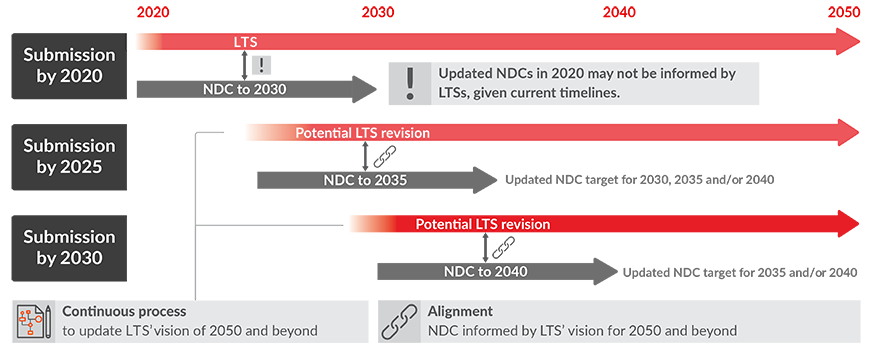
Proposal for harmonised revision cycles of NDCs and LTSs for alignment of climate commitments. Source: LTS Guide to Policymakers, 2020, p. 10
The timeline for submission of updated NDCs and the first submissions of LTSs in 2020 gives policy makers an opportunity to use their LTSs to inform their updated medium-term targets. However, current climate policy planning processes at the national level for 2020 do not often account for such alignment between NDCs and LTSs. In many country contexts, the development of LTSs simply will not happen in time to inform the NDC target setting in 2020. For this reason, some updated NDCs may not be informed by upcoming LTSs in 2020.
Looking ahead to future revision cycles beyond 2020, policy makers can proactively steer climate policy planning processes – both at the national and sectoral level – to align NDC revisions mandated by the Paris Agreement with updates to the country’s long-term vision outlined in the LTS. For example, policy makers could align processes in a way that LTSs will be updated in regular five-year intervals to inform future NDC submissions.
Cyclical long-term planning reduces resources needed to achieve net zero emissions
Comparing trajectories that represent the highest possible ambition with current policy or commitment pathways, reveals a gap that can only be closed with additional technical and financial resources (represented by dark blue and red lines respectively in the diagram below). While this gap may seem daunting if viewed as a one-off exercise, more can be done with a more efficient use of resources, if long term-planning is approached as a recurring iterative process (red dotted vertical lines). A long-term planning process can include regular short-term planning cycles, informed by long-term objectives, as described in the previous section. In that way, regular NDC or national climate action planning cycles could provide an opportunity to regularly reassess current policy pathways, and new developments which may affect the range of possible ambition (light blue line).
The regular reassessment of these pathways may reveal that it is possible to achieve deeper emission reductions than what might have been previously anticipated from the resources invested in the previous period (yellow line). This can occur, for example, when tipping points for mass diffusion of transformational technologies and practices are reached, and through the resulting spill-over effects of progress between countries.
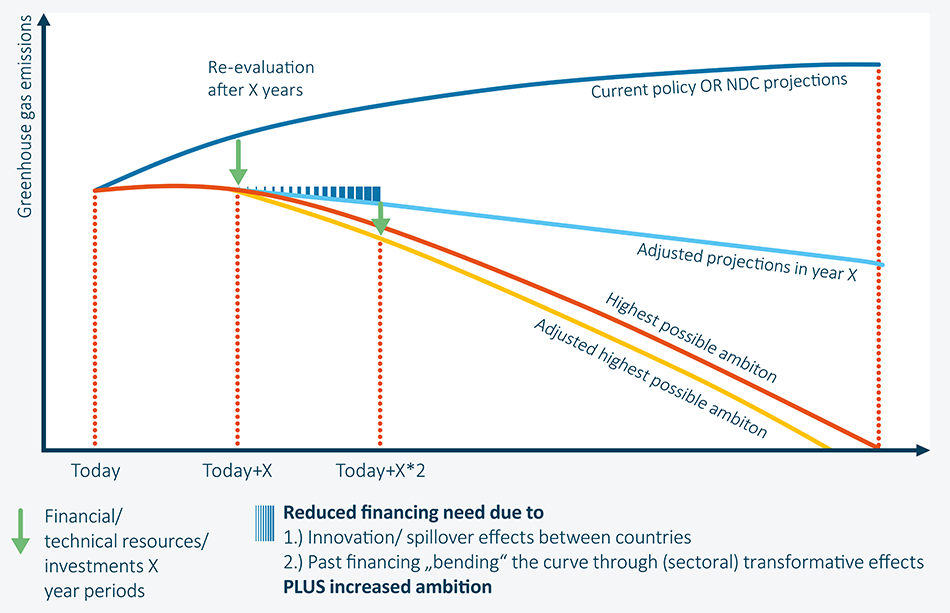
Periodical review of short- and long-term planning and its effect on financial and technical resources need. Source: NDC Update Report 2019, p. 27
Technology development is a largely global process; while technological spill-over is context dependent, most solutions are relevant beyond the contexts in which they were originally designed. In turn this means that a few actors can initiate change well beyond their original jurisdiction. This can be observed for renewable energy development, where a few countries have initiated a global trend, but also recently for electric vehicles, where the support of a few jurisdictions such as Norway, China or California have reduced the technical and financial resources needed in second mover countries such as Germany (“reduced financing need” in the figure above).
An ongoing iterative process to climate change mitigation planning can help ensure improved alignment with the long-term goals under the Paris Agreement. While there is considerable risk that the trajectories most countries initially identify as their highest possible ambition pathways are not fully Paris compatible, consecutive adjustments of the pathway can close this gap. This logic also demonstrates the importance and attractiveness of early action, since increasing the level of resources invested at an early stage can allow for readjustment of trajectories in a way that significantly reduces resource requirements to move towards the long-term objectives in the future.
More information on the following inputs available in Chapter 2 (LTS development under country-specific circumstances) of the guide on ‘Making long-term low GHG emissions development strategies (LTSs) a reality – A guide to policy makers on how to develop an LTS for submission in 2020 and future revision cycles developed’.
The typology introduced in this section aims to acknowledge and account for the different starting points of countries to develop their LTS in 2020. The country-specific starting points can differ both in available human and financial resources to develop an LTS as well as in political leadership and experience in reaching consensus for long-term visions. In this context, the figure below outlines the rationale for three interlinked LTS types, building upon one another: a base version, an intermediate version, and a detailed version. While some countries might opt for a base version for submission to the UNFCCC in 2020 or shortly thereafter, they can explicitly communicate support needs to the international community in order to submit a more substantiated version in future revision cycles.
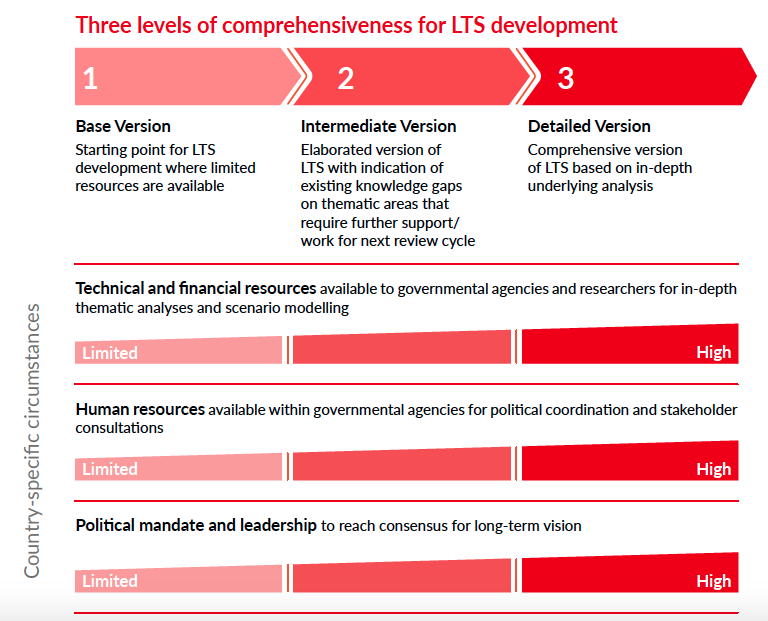
Concept of three levels of comprehensiveness to guide the development of long-term low GHG emission development strategies (LTSs) and respective characteristics. Source: LTS Guide to Policymakers, 2020, p. 13
An increasing body of recently published literature identifies key aspects that countries can consider when conceptualising and developing their LTSs in 2020 or thereafter. While most authors acknowledge the relevance of certain aspects in the elaboration of a country’s long-term vision, no common understanding currently exists on how countries can take up these aspects in their LTSs.
The table below presents a differentiated approach on how policy makers can address each aspect considering their country’s situation. Policy makers have full flexibility to customise this approach to country-specific circumstances, for example by choosing a suitable level of detail for each listed aspect.
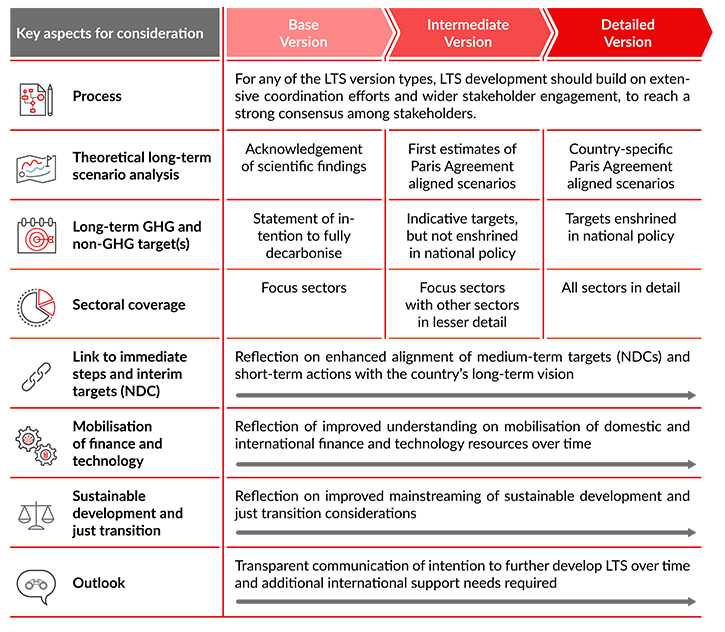
Key aspects for consideration in an ongoing LTS development process. Source: LTS Guide to Policymakers, 2020, p. 14
More information on the following inputs available in Chapter 2.3.2 (Theoretical long-term scenario analysis) and the Annex of the guide on ‘Making long-term low GHG emissions development strategies (LTSs) a reality – A guide to policy makers on how to develop an LTS for submission in 2020 and future revision cycles developed’.
Updating theoretical scenario modelling over time in line with harmonised revision cycles
Long-term scenario analysis on GHG emission pathways until 2050 can provide a theoretical underpinning to inform a country’s long-term vision. Policy makers can use this scenario analysis to set a vision for achieving full decarbonisation across all sectors and perform analysis to evaluate whether the vision is compatible with the Paris Agreement’s temperature limit. The analysis can also directly inform the GHG and non-GHG target setting in line with developed scenarios.
The figure below illustrates in a stylised manner how a country can develop long-term scenario pathways in 2020 and subsequently update these before 2025, in time to inform the next NDC review and revision cycle of 2025. A subsequent update could then take place before 2030 to inform the NDC review and revision cycle of 2030 (not displayed in this figure).
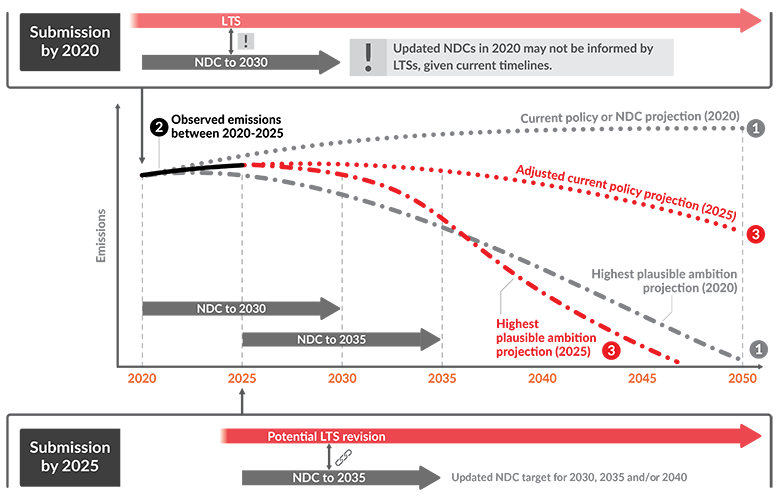
Updating the theoretical scenario modelling over time in line with harmonised revision cycles. Source: LTS Guide to Policymakers, 2020, p. 33
- First scenario modelling in 2020 (grey lines in graph): A first theoretical scenario modelling is conducted in 2020 for both a current policy scenario and highest plausible ambition scenario, ideally informed by a process involving policy makers, sector experts, and modelers. Policy makers can include other scenario types such as a realistic unilateral ambition scenario as well (not displayed in this figure).
- GHG emissions pathway between 2020 and 2025 (black lines in graph): The observed GHG emissions between 2020 and 2025 reflect the level of mitigation ambition implemented in the short-term. These observed emissions between 2020-2025, as stylised here, might be above a highest plausible ambition scenario given the challenges to effectively adjust (sector-level) planning, redirect spending of fiscal revenues, and deploy low-carbon technologies to the highest extend possible in the given time frame.
- Updated scenario modelling in 2025 (red lines in graph): After five years, the updated theoretical scenario modelling in 2025 can account for latest technological, economic, societal, and policy developments. Both the current policy scenario and highest plausible ambition scenario can thereby include most recent developments in technological innovation, spill-over effects from other countries (cost reductions for low-carbon technologies for example), past finance “bending” the curve through (sectoral) transformation effects, and higher level of mitigation ambitions considered realistic.
More information on the following inputs available in Chapter 4 (Alignment of LTSs in the context of the Paris Agreement) of the ‘NDC Update Report December 2019 – Long-term, society-wide visions for immediate action’.
When considering the suitability of different approaches as analytical inputs, it is important to note that the determination of a country’s highest possible ambition level will depend on global as well as national considerations. As no country functions in isolation, global technology trends play an important role in determining what is possible. These technology trends need to be considered in the national context. This can play out very differently in countries depending on the extent of lock-in to existing infrastructure, domestic market readiness, cultural norms and institutional capacities. This underlines the importance of a broad participatory national process.
While transformative technologies may be more mature and available in some sectors than others, it is important that the planning process includes a sufficiently broad sector coverage to ensure that the highest possible ambition can be achieved with the most efficient use of resources. The oversight of potential levers in some sectors could lead to higher overall costs.
Determining the highest possible level of ambition is therefore a carefully designed process in which national processes make best possible use of the latest available insights from both bottom-up and top-down analytical approaches. The relative strengths and weaknesses of these approaches as an analytical input to a national-driven process for determining highest possible ambition are summarised in the table below.
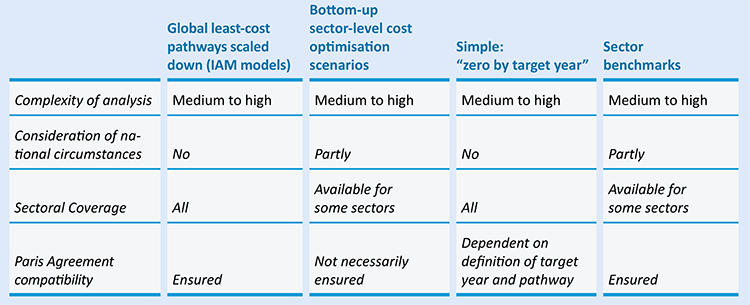
Comparison of different modelling approaches to take as an analytical input for determining a country’s highest possible ambition for domestic GHG emission reduction. Source: NDC Update report 2019, p.29.
- Global least-cost pathways scaled down are the output of models that distribute global pathways or carbon budgets across countries and sectors using the assumption that emissions are best mitigated where it is cheapest to do so. Such pathways are produced in particular by Integrated Assessment Models (IAMs) as they are for instance agglomerated in the IPCC special report on 1.5 (IPCC, 2018b). The main advantage of IAMs is their comprehensiveness, as they take a broad view of the economy and simulate interactions between economic sectors. Their disadvantage is however their limited resolution at the sectoral and national level. The lack in sectoral resolution leads to a reliance on negative emission technologies in the latter half of this century in these models, and underestimates what can be done at the sectoral level. Since most models only provide results at the regional level, assumptions have to be made to downscale these to the country level (Sferra et al., 2019). Most importantly, IAMs produce a range of potential pathways from which it is not always straightforward to identify the most appropriate one.
- Bottom-up sector-level cost optimisation scenarios that focus on technologies can be more granular at the sectoral level than top-down models. Depending on their setup, they can often also be useful for quantifying the impact of policies in specific sectors (DEA, OECD, 2013; Krey et al., 2019). Examples of such scenarios are the IEA ETP, IEA WEO model, the Ecofys Energy report, Greenpeace‘s Energy [R] evolution scenarios and the CAT scaling up series (Jeffries et al., 2011; Teske, Sawyer and Ash, 2012; IEA, 2017, 2018; CAT, 2018; Climate Action Tracker, 2018). Some of these scenarios go beyond cost optimised pathways and consider other aspects, such as how easy it is to implement policies from an institutional perspective. While providing more detailed resolution at the sector level, such scenarios are often at the regional level, and often lack transparency in their assumptions, which can make it difficult to translate regional results to the national level.
- A simple interpretation of the goal to achieve zero emissions by a target year (e.g. 2050) can be built on the findings of the IPCC special report on 1.5 °C warming: the need to achieve net-zero CO2 Emissions by 2050 and net zero GHG emissions by 2070. The strength of this approach is that it contrasts the model- based approaches by providing a simple and transparent manner to derive pathways. It requires the definition of only two elements –a target year for net-zero emissions and a trajectory to get there – and could be differentiated by sector. In a simplified representation, these pathways could be linear, exponential or follow an S-curve. They should reflect how a country thinks it can best reach net- zero by the target year. Its relative simplicity makes it easier to communicate across a wide set of actors in an economy.
- (Paris compatible) sectoral benchmarks summarise the insights from different approaches to derive benchmarks (often expressed as ranges) that are in line with the required long-term global low-carbon transition. The benchmarking project of the Climate Action Tracker and the paper on “Ten key short-term sectoral benchmarks to limit warming to 1.5°C” are examples of developing benchmarks (Climate Action Tracker, 2016; Kuramochi et al., 2017).
More information on the following inputs available in Chapter 5 (Overview of submitted LTS and Highlights) of the ‘NDC Update Report December 2019 – Long-term, society-wide visions for immediate action’.
Overview of submitted LTS as of December 2019
We reviewed all 14 LTS that had been submitted by December 2019 considering the aspects highlighted above. While the content and process seem to vary greatly, common highlights can be seen for certain key elements. Stakeholder engagement and participatory processes are a key element of LTSs, most LTSs link to or plan the elaboration of national plans and regulations, a majority of countries present their LTS as “living documents” and although there are discrepancies in the understanding of Paris Aligned pathways, we see positive developments in countries aiming for net-zero emissions.
Long-term Strategy Tracker (See full table)
Highlights of submitted LTSs
- Link to or elaboration of national plans and regulations: The UK enshrines long-term climate targets in national policy
The UK’s LTS is based on existing legislation such as the Climate Change Act (2008), which commits the UK government by law to reduce greenhouse gas emissions. In parallel to the LTS, the 80% reduction target by 2050 was amended in June 2019 to “at least 100% of 1990 levels (net zero) by 2050”.
The Act includes the setting of sectoral carbon budgets to be revised by the Secretary of State every four years. It is noteworthy to mention that while the long-term mitigation target was amended, the carbon budgets are still based on the previous target of an 80% reduction. The Act led to non-GHG targets, most notably UK’s coal phase-out by October 2014. - Pathways for GHG emissions until 2050 and beyond in line with the long-term temperature goal of the Paris Agreement: Portugal’s country-specific Paris Agreement aligned scenarios
Portugal’s LTS acknowledges the latest science and references the Paris Agreement temperature limit and the IPCC Special Report on 1.5°C, which both frame the need for full decarbonisation by 2050. The economy-wide scenarios behind the LTS were developed in iterative phases gathering contributions from and peer-reviewing of various national institutions and experts, for instance through technical workshops on assumptions and trends.
The process resulted in three comprehensive scenarios encompassing all sectors, tailored to country-specific circumstances and based on robust methodologies (e.g. 2006 IPCC guidelines) and models (e.g. the TIMES_PT optimisation model for the energy sector or GEM-E3_PT, a dynamic, general equilibrium recursive model aggregating all sectors across the economy). In a final step, a draft of the LTS underwent a three months consultation process to engage stakeholders in a series of events and to gather feedback.
- Ongoing visioning exercise: Transparent communication of intention to future develop LTS over time
The LTSs of Ukraine, the Republic of Marshall Islands and France all include statements of intentions to review and revise their LTSs at least every five years. The proposed frequency of updates in five-year intervals corresponds to the NDC revision cycles mandated by the Paris Agreement. The Czech Republic’s LTS explicitly aims to (re-)evaluate its long-term vision by the end of 2021 to publish a revised LTS by the end of 2023.
- Back-casting exercise (link to NDC or medium-term national targets): Fiji’s enhanced alignment of medium-term targets (NDCs) and short-term actions’
Fiji’s LTS builds onto existing mitigation and adaptation actions that are being undertaken by the Fijian government. Furthermore, the LTS is seen as a “a key tool, a guiding light, and a fundamental pillar” to inform, enhance and raise ambition of future NDCs. The LTS provides emission targets in five-year intervals between 2020 and 2050 in all scenarios developed in the LTS process. A key pillar of Fiji’s LTS is to reflect on immediate, short-, medium- and long-term priority actions informed by long-term pathway scenarios. The LTS sets “both economy-wide and sector-specific development targets” linked to Fiji’s NDC, which spans from 2017 to 2036 (see Table 2 of the LTS).
The LTS’s annex provides a long list of policy actions by sector. For each policy action, the LTS provides an implementation timeframe, a main implementing institution, an approximation of finance required and the long-term scenario the policy related to. A further step would be to settle on a long-term scenario and develop actionable immediate, short- and medium-term policies.
Relevant reports of LTS guidance:
- CAN Europe (2018) ‘G20 Issue Brief – Long-term Strategies Suggested’. Available at: http://www.climatenetwork.org/publication/can-g20-issue-brief-long-term-strategies-may-2018.
- Cox, S. (2019) ‘Lessons from low-emissions development strategies to support long-term strategy development and implementation’. LEDS Global Partnership Case, (March 2019), pp. 1–14. Available at: https://www.wri.org/publication/lessons-low-emission-development-strategies-support-long-term-strategy-development-and.
- Ecologic Institute (2017) ‘“Paris Compatible” Governance: long-term policy frameworks to drive transformational change’. Ecologic Institute. Available at: https://www.ecologic.eu/15218.
- Levin, K. et al. (2018) ‘Long-Term Low Greenhouse Gas Emission Development Strategies’. WRI, UNDP, (August). Available at: https://wriorg.s3.amazonaws.com/s3fs-public/long-term-low-greenhouse-gas-emission-development-strategies.pdf?_ga=2.104118978.353508219.1550759266-938025902.1550759266.
- Roeser, F. et al. (2019) ‘NDC Update Report – Long-term, society-wide visions for immediate action.’ Berlin, Germany. Available at: NDC Update Report December 2019 – Long-term, society-wide visions for immediate action.
- Waisman, H. et al. (2019) ‘A pathway design framework for national low greenhouse gas emission development strategies’, Nature Climate Change. Nature Publishing Group, 9(4), pp. 261–268. doi: 10.1038/s41558-019-0442-8.
- Williams, J. and Waisman, H. (2017) ‘2050 Pathways: A Handbook’. 2050 Pathways Platform 2050, (July), p. 44. Available at: www.2050pathways.org.
- WRI (2019) ‘Scaling Up Ambition: Leveraging Nationally Determined Contributions and Long-Term Strategies to Achieve the Paris Agreement Goals.’ Available at: https://www.wri.org/publication/scaling-up-ambition/.
Tracking LTS submission:
- ClimateWatch (2020) ‘Long-Term Strategy Tracker’. Available at: https://www.climatewatchdata.org/lts-tracker.
- UNDP (2019) ‘The Heat is On – Taking Stock of Global Climate Ambition’. UNDP. Available at: https://outlook.ndcs.undp.org/.
- UNFCCC (2020) Communication of long-term strategies. Available at: https://unfccc.int/process/the-paris-agreement/long-term-strategies.



